Public Perceptions of Renewable Energy in the Philippines
Abstract
:1. Introduction
1.1. The Current State of RE in the Philippines
1.2. Public Acceptance
1.3. Aims of the Study
- How much support is there for RE in the Philippines?
- What are the factors that influence this support?
- Does this support manifest itself in the form of willingness to install (WTI)?
2. Materials and Methods
Data Collection and Questions
- Personal:
- -
- Pollfish provided demographic data on gender, location, income, occupational and marital status, number of children, education, and year of birth (which was changed for analysis purposes into age brackets).
- Social-psychological:
- -
- Perception of the climate crisis; participants were given six options, ranging from ‘not a serious problem that can be easily ignored’, to ‘it is a serious crisis that requires major economic and social change’ (Likert scale).
- -
- The priority given to addressing the crisis in relation to economic growth, ranging from ‘economy comes first’ to ‘environment comes first’ (Likert scale).
- -
- Self-declared knowledge of different types of energy sources (Likert scale).
- -
- The extent to which different actors are responsible for reducing the climate crisis, including government, industry, the individual, or natural processes (Likert scale).
- -
- Whether different types of energy should be expanded or not, including RE in general, different types of RE, fossil fuels, and nuclear energy (Likert scale).
- -
- How RE should be financed; respondents were presented with a list of financing sources such as general taxation, a levy, taxation on fossil fuels, etc., and a four-point scale from zero contribution to major contribution (Likert scale).
- -
- Respondents were asked to rank commonly given arguments for and against RE as good, bad, or unimportant (three-point Likert scale).
- -
- How much trust respondents placed in the actions and statements of various actors, including central and local governments, the media, RE campaigners, and energy providers (Likert scale).
- Contextual:
- -
- Respondents were asked if they were in a rural or urban area (binary item).
- -
- Their exposure to RE, ranging from none to having it at home, at work, in the community, or working for an RE company (categorical item).
- -
- Their experience with power outages, from daily to zero (categorical).
- -
- The importance of the impact of RE on indigenous cultures and the wider environment (Likert scale).
3. Results
3.1. Analysis Methodology
3.2. Descriptive Results
3.2.1. Demographic Details
3.2.2. Investment in RE, WTI, and Willingness to Pay
3.2.3. Knowledge of Energy Sources
3.2.4. Perceptions of the Climate Crisis
3.2.5. Contributing to RE Investment
3.2.6. Other Variables
3.3. Statistical Analysis and Modelling of Variables
3.3.1. Regression Analysis of Overall Support for RE
3.3.2. Regression Analysis of WTI
4. Discussion
5. Conclusions
Author Contributions
Funding
Institutional Review Board Statement
Informed Consent Statement
Data Availability Statement
Acknowledgments
Conflicts of Interest
Abbreviations
| FiT | Feed-in-Tariff |
| FiT-All | Feed-in-Tariff Allowance |
| RE | Renewable Energy |
| UNDP | United Nations Development Programme |
| WTI | Willingness to Install |
| WTP | Willingness to Pay |
References
- Asian Development Bank. Philippines: Energy Sector Assessment, Strategy, and Road Map; Asian Development Bank: Mandaluyong, Philippines, 2018. [Google Scholar]
- Ember. Countries and Regions: Electricity Trends. 2022. Available online: https://ember-climate.org/countries-and-regions/ (accessed on 28 June 2022).
- Yokota, E.; Kutani, I. Comparative Analysis of Power Prices in the Philippines and Selected ASEAN Countries. 2018. Available online: https://www.eria.org/research/comparative-analysis-of-power-prices-in-the-philippines-and-selected-asean-countries/ (accessed on 2 July 2022).
- Lectura, L. Average Electricity Price in PHL 2nd Highest in Asia–Think Tank. 2018. Available online: https://businessmirror.com.ph/2018/08/07/average-electricity-price-in-phl-2nd-highest-in-asia-think-tank/ (accessed on 2 July 2022).
- Lackovic, M.; Ruiz-Cabrero, J. Powering up Philippines’ Renewable Ambitions with Rooftop Solar. 2021. Available online: https://www.bworldonline.com/opinion/2021/11/09/409305/powering-up-philippines-renewable-ambitions-with-rooftop-solar/ (accessed on 29 June 2022).
- Gunther, E.A. Vietnam Rooftop Solar Records Major Boom as More than 9 GW Installed in 2020. Available online: https://www.pv-tech.org/vietnam-rooftop-solar-records-major-boom-as-more-than-9gw-installed-in-2020/ (accessed on 29 June 2022).
- Energy Regulatory Commission. Resolution No. 06, Series of 2019: A Resolution Adopting the Amendments to the Rules Enabling the Net-Metering Program for Renewable Energy. 2019. Available online: https://www.erc.gov.ph/Files/Render/issuance/29981 (accessed on 30 July 2022).
- Gatchalian, W. An Act Enhancing the Implementation of the Net-Metering Program, Amending for the Purpose Republic Act No. 9513, Otherwise Know as the Renewable Energy Act of 2008. 2021. Available online: https://wingatchalian.com/wp-content/uploads/2021/05/3505531885.pdf (accessed on 28 June 2022).
- Solaric. Net Metering: The Process and Why It Takes Time—Solar Panels Philippines. 2019. Available online: https://solaric.com.ph/blog/process-net-metering/ (accessed on 29 June 2022).
- Verzola, R. Microrenewables. 2019. Available online: https://rverzola.files.wordpress.com/2019/08/mr11_vol4_08282019_final_8am.pdf (accessed on 13 April 2022).
- Verzola, R. Microrenewables. 2019. Available online: https://rverzola.files.wordpress.com/2019/11/mr12_vol4_1104_final.pdf (accessed on 13 April 2022).
- Roxas, F.; Santiago, A. Alternative framework for renewable energy planning in the Philippines. Renew. Sustain. Energy Rev. 2016, 59, 1396–1404. [Google Scholar] [CrossRef]
- Barroco, J.; Herrera, M. Clearing barriers to project finance for renewable energy in developing countries: A Philippines case study. Energy Policy 2019, 135, 111008. [Google Scholar] [CrossRef]
- Lagac, J.M.P.; Yap, J.T. Evaluating the feed-in tariff policy in the Philippines. Int. J. Energy Econ. Policy 2021, 11, 419–425. [Google Scholar] [CrossRef]
- Bertheau, P.; Dionisio, J.; Jütte, C.; Aquino, C. Challenges for implementing renewable energy in a cooperative-driven off-grid system in the Philippines. Environ. Innov. Soc. Transit. 2020, 35, 333–345. [Google Scholar] [CrossRef]
- Guild, J. Feed-in-tariffs and the politics of renewable energy in Indonesia and the Philippines. Asia Pac. Policy Stud. 2019, 6, 417–431. [Google Scholar] [CrossRef] [Green Version]
- Rababah, H.E.; Ghazali, A.; Isa, M.H.M. Building Integrated Photovoltaic (BIPV) in Southeast Asian Countries: Review of Effects and Challenges. Sustainability 2021, 13, 12952. [Google Scholar] [CrossRef]
- Marquardt, J. How Power Affects Policy Implementation: Lessons from the Philippines. J. Curr. Southeast Asian Aff. 2017, 36, 3–27. [Google Scholar] [CrossRef] [Green Version]
- Fatima, N.; Li, Y.; Ahmad, M.; Jabeen, G.; Li, X. Factors influencing renewable energy generation development: A way to environmental sustainability. Environ. Sci. Pollut. Res. 2021, 28, 51714–51732. [Google Scholar] [CrossRef]
- Taufik, D.; Dagevos, H. Driving public acceptance (instead of skepticism) of technologies enabling bioenergy production: A corporate social responsibility perspective. J. Clean. Prod. 2021, 324, 129273. [Google Scholar] [CrossRef]
- Gareiou, Z.; Drimili, E.; Zervas, E. Public acceptance of renewable energy sources. In Low Carbon Energy Technologies in Sustainable Energy Systems; Elsevier: Amsterdam, The Netherlands, 2021; pp. 309–327. [Google Scholar]
- Cousse, J. Still in love with solar energy? Installation size, affect, and the social acceptance of renewable energy technologies. Renew. Sustain. Energy Rev. 2021, 145, 111107. [Google Scholar] [CrossRef]
- Makki, A.A.; Mosly, I. Factors Affecting Public Willingness to Adopt Renewable Energy Technologies: An Exploratory Analysis. Sustainability 2020, 12, 845. [Google Scholar] [CrossRef] [Green Version]
- Lucas, H.; Carbajo, R.; Machiba, T.; Zhukov, E.; Cabeza, L.F. Improving Public Attitude towards Renewable Energy. Energies 2021, 14, 4521. [Google Scholar] [CrossRef]
- Devine-Wright, P. Reconsidering public acceptance of renewable energy technologies: A critical review. In Delivering a Low Carbon Electricity System; Grubb, M., Jamasb, T., Pollitt, M.G., Eds.; Cambridge University Press: Cambridge, UK, 2008; pp. 443–461. [Google Scholar]
- Bollettino, V.; Alcayna-Stevens, T.; Sharma, M.; Dy, P.; Pham, P.; Vinck, P. Public perception of climate change and disaster preparedness: Evidence from the Philippines. Clim. Risk Manag. 2020, 30, 100250. [Google Scholar] [CrossRef]
- UNDP. Peoples’ Climate Vote Results, 2021. Available online: https://www.undp.org/publications/g20-peoples-climate-vote-2021 (accessed on 27 June 2022).
- Philippine Statistical Authority. Population and Housing Statistical Tables. 2022. Available online: https://psa.gov.ph/population-and-housing/statistical-tables (accessed on 29 June 2022).
- NGCP Completes Integral Components of Mindanao-Visayas Interconnection Project—SUNSTAR. 2022. Available online: https://www.sunstar.com.ph/article/1933553/bacolod/business/ngcp-completes-integral-components-of-mindanao-visayas-interconnection-project (accessed on 2 July 2022).
- Dalusung, A.; Manansala, J. Who Is Profiting from the Power Outages? 2021. Available online: https://businessmirror.com.ph/2021/09/04/who-is-profiting-from-the-power-outages/ (accessed on 2 July 2022).
- Jamieson, S. Likert scales: How to (ab) use them? Med. Educ. 2004, 38, 1217–1218. [Google Scholar] [CrossRef] [PubMed]
- Kuzon, W.; Urbanchek, M.; McCabe, S. The seven deadly sins of statistical analysis. Ann. Plast. Surg. 1996, 37, 265–272. [Google Scholar] [CrossRef] [PubMed]
- Norman, G. Likert scales, levels of measurement and the “laws” of statistics. Adv. Health Sci. Educ. 2010, 15, 625–632. [Google Scholar] [CrossRef] [PubMed]
- Sullivan, G.M.; Artino, A.R., Jr. Analyzing and Interpreting Data From Likert-Type Scales. J. Grad. Med. Educ. 2013, 5, 541–542. [Google Scholar] [CrossRef] [PubMed] [Green Version]
- Venables, W.N.; Ripley, B.D. Modern Applied Statistics with S, 4th ed.; Springer: New York, NY, USA, 2002. [Google Scholar]
- Revelle, W. psych: Procedures for Psychological, Psychometric, and Personality Research; R Package Version 1.5.8; Northwestern University: Evanston, IL, USA, 2015. [Google Scholar]
- Lüdecke, D. sjPlot: Data Visualization for Statistics in Social Science; R Package Version 2.8.10; Zenodo: Meyrin, Switzerland, 2021. [Google Scholar]
- Karasmanaki, E. Understanding willingness to pay for renewable energy among citizens of the European Union during the period 2010–2020. In Low Carbon Energy Technologies in Sustainable Energy Systems; Kyriakopous, G.L., Ed.; Elsevier: Amsterdam, The Netherlands, 2021; pp. 141–161. [Google Scholar] [CrossRef]
- Energy Regulatory Commission. ERC Approves a Lower Feed in Tariff Allowance. 2020. Available online: http://www.erc.gov.ph/ContentPage/62245 (accessed on 7 April 2022).
- Energy Regulatory Commission. ERC Approves a Lower Feed-in Tariff Allowance. 2019. Available online: https://www.erc.gov.ph/ContentPage/61912#collapse2019 (accessed on 7 April 2022).
- Energy Regulatory Commission. ERC Suspends FIT-All Collection to Lower Electricity Rates. 2020. Available online: https://www.erc.gov.ph/ContentPage/61946 (accessed on 11 April 2022).
- Meralco. Summary Schedule of Rates Effective July 2020 Billing. 2020. Available online: https://meralcomain.s3.ap-southeast-1.amazonaws.com/2020-07/07-2020_rate_schedule.pdf (accessed on 11 April 2022).
- Fullerton, A.S.; Xu, J. Ordered Regression Models; Taylor & Francis Group: Abingdon, UK, 2016. [Google Scholar]
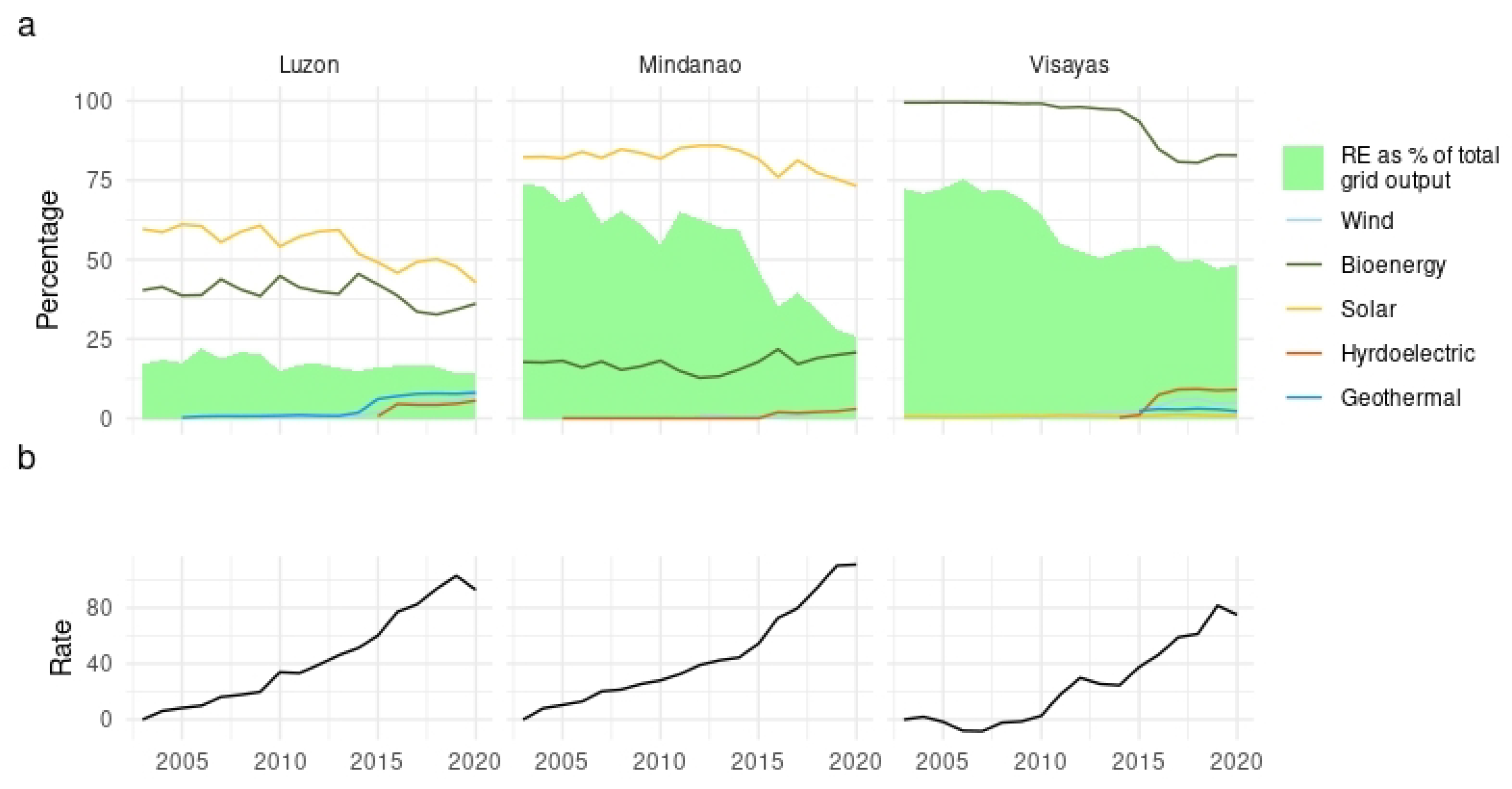

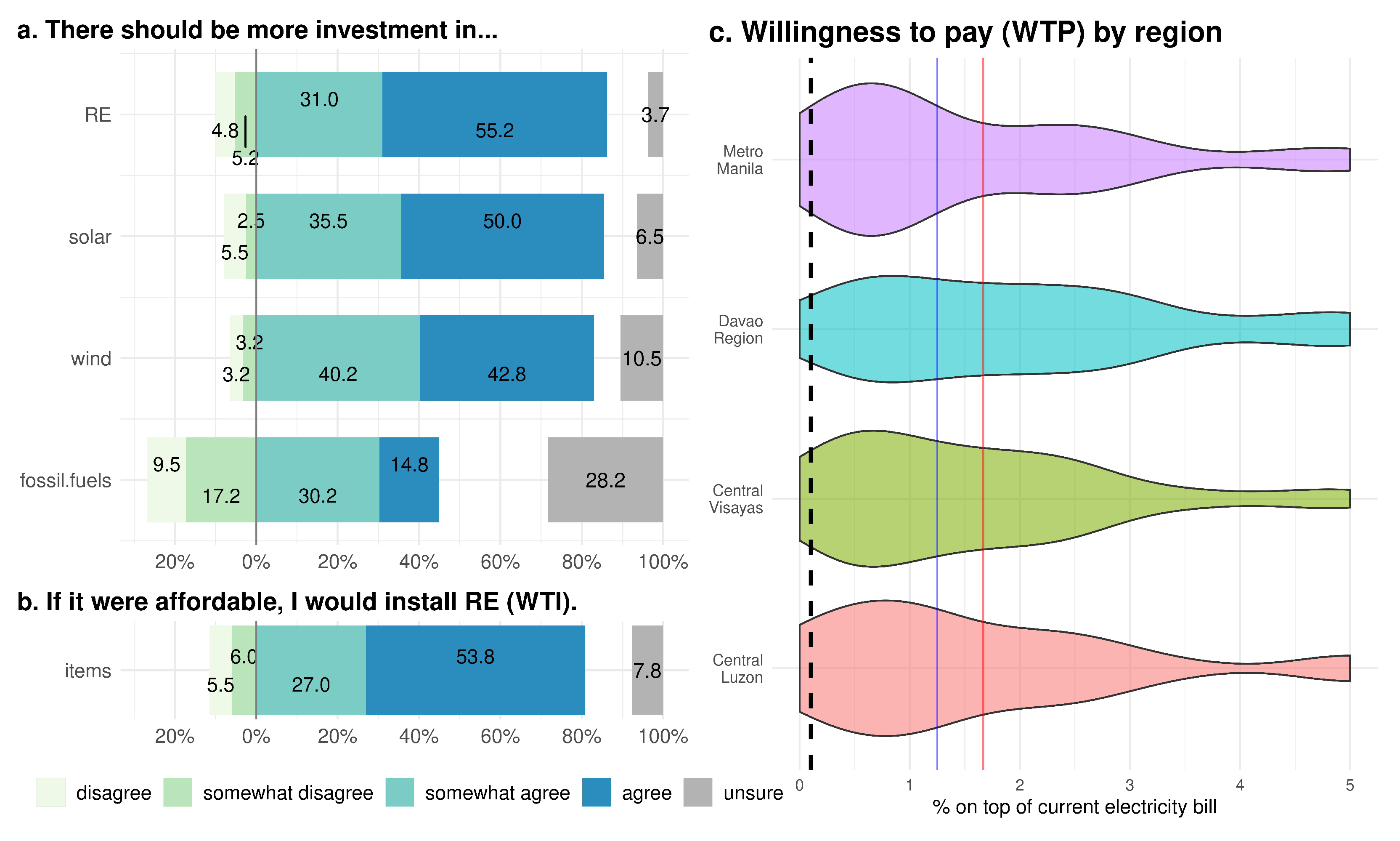
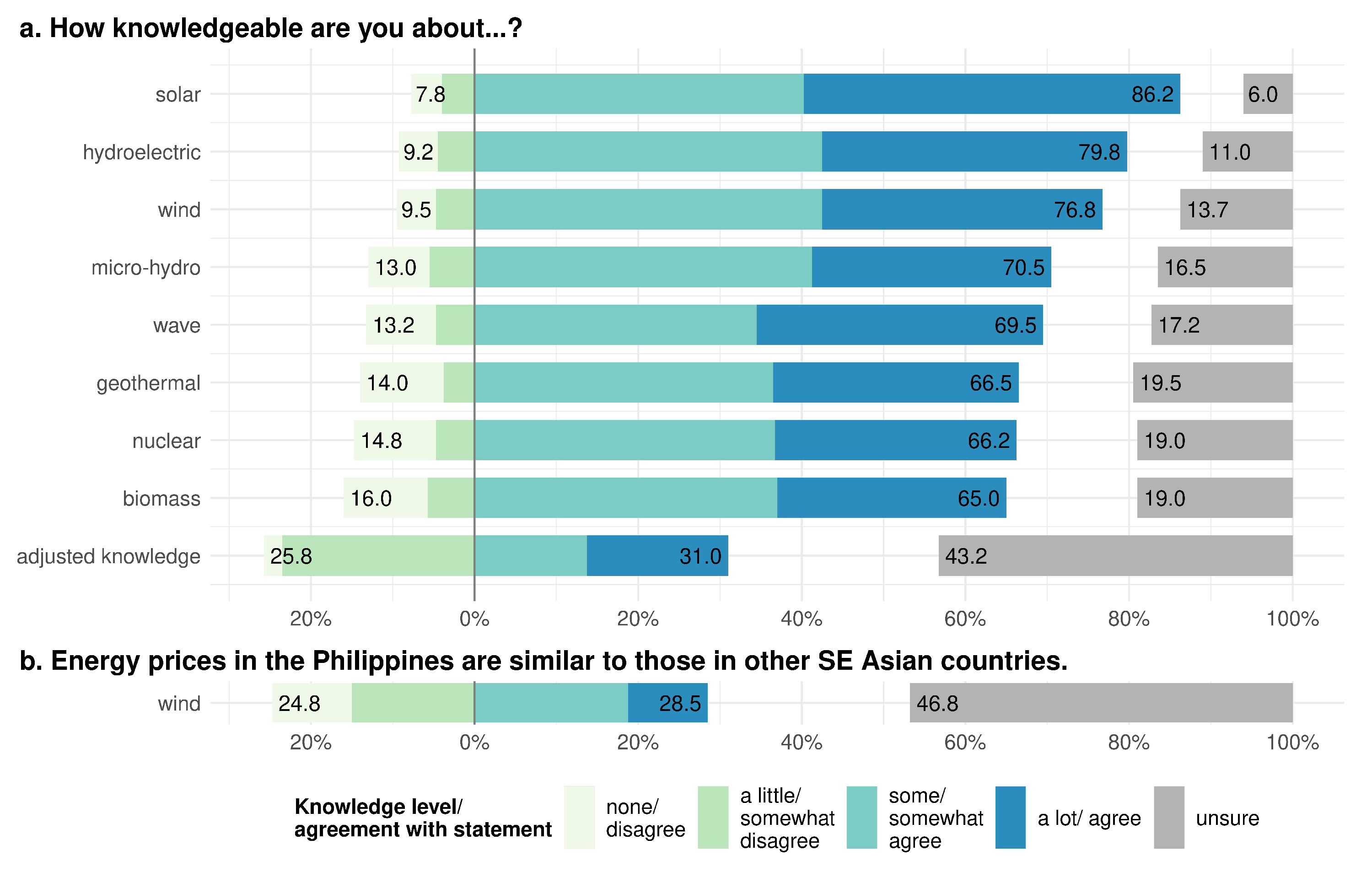
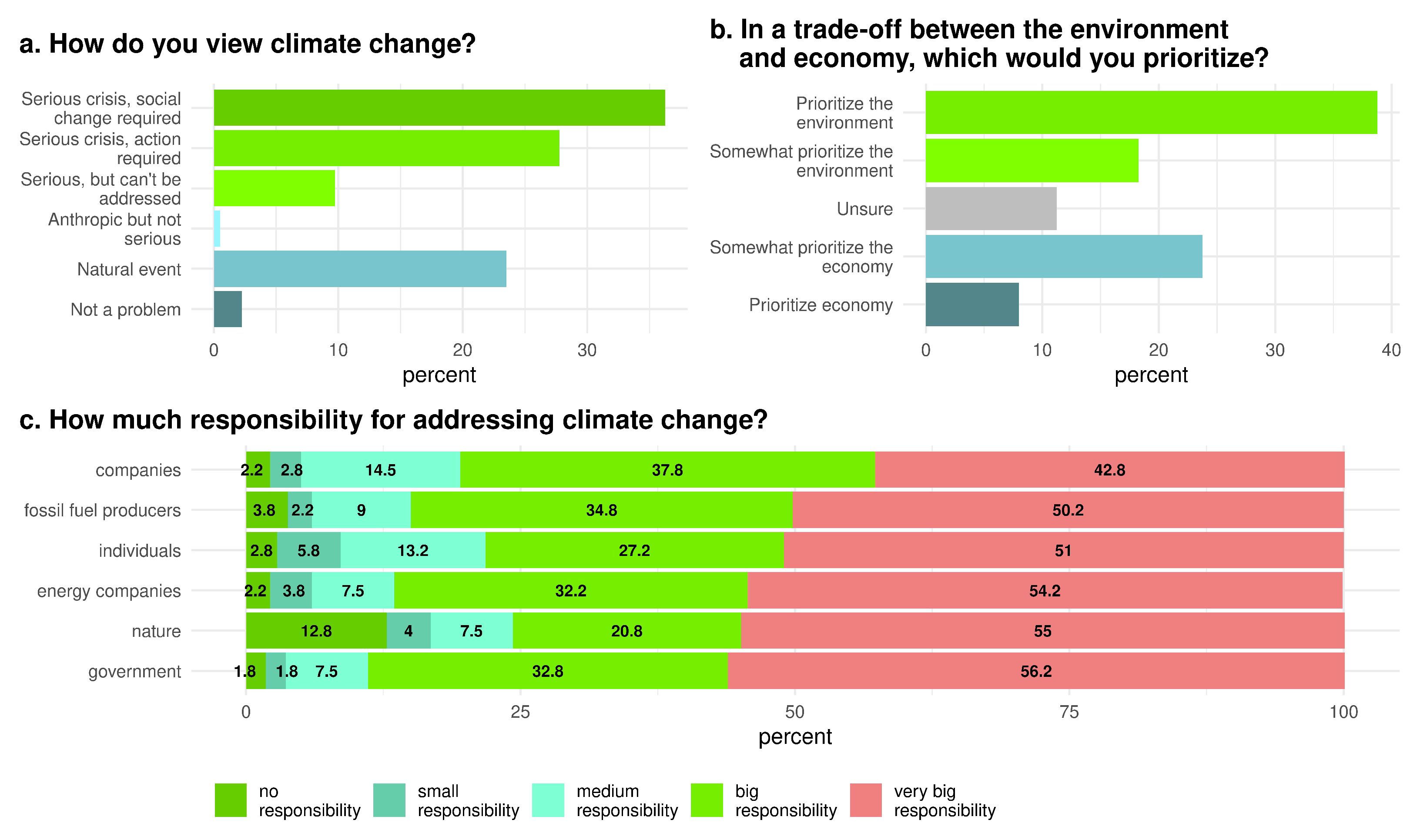
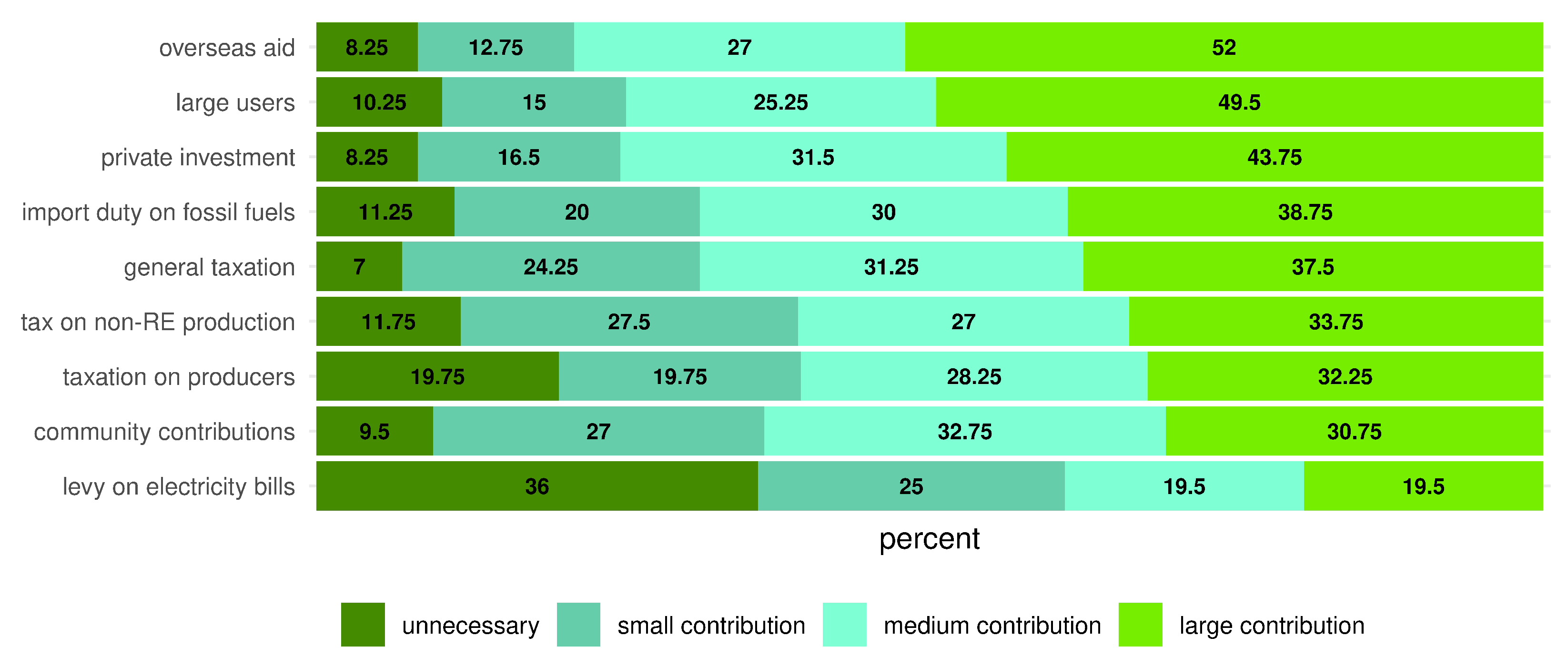
| Variable | Distribution | N | % |
|---|---|---|---|
| Gender | female | 240 | 60.0 |
| male | 160 | 40.0 | |
| Location 1 | rural | 168 | 42.0 |
| urban | 232 | 58.0 | |
| Age Group | 18–24 | 124 | 31.0 |
| 25–34 | 138 | 34.5 | |
| 35–44 | 97 | 24.2 | |
| 45–54 | 27 | 6.8 | |
| 55 and over | 14 | 3.5 | |
| Marital status | married/cohabit | 139 | 34.8 |
| single/other | 261 | 65.2 | |
| Children | none | 221 | 55.2 |
| present | 179 | 44.8 | |
| Education | high school | 136 | 34.0 |
| college | 77 | 19.2 | |
| university | 168 | 42.0 | |
| post-graduate | 19 | 4.8 | |
| Employment | employed | 137 | 34.2 |
| homemaker | 41 | 10.2 | |
| student | 77 | 19.2 | |
| self-employed | 59 | 14.8 | |
| unemployed | 42 | 10.5 | |
| other | 44 | 11.0 | |
| Income (PHP) | under 150,000 (Lower 1) | 176 | 44.0 |
| 150,000∼299,999 (Lower 2) | 65 | 16.3 | |
| 300,000∼449,999 (Middle 1) | 35 | 8.8 | |
| 500,000∼749,999 (Middle 2), | 24 | 6.0 | |
| 750,000∼1,249,999 (Upper 1) | 13 | 3.3 | |
| 1,250,000∼1,999,999 (Upper 2) | 5 | 1.3 | |
| 2,000,000 and over (Upper 3) | 7 | 1.75 | |
| unreported | 75 | 18.8 |
| Variables | Responses | |
|---|---|---|
| 5-Point Likert Questions | ||
| somewhat agree (%) | agree (%) | |
| More cooperation necessary between local and central governments to improve RE effectiveness | 32.75 | 49.0 |
| RE should be subsidised | 39.25 | 36.75 |
| Fossil fuels are reliable compared to RE | 41.25 | 21.25 |
| Good/Bad Arguments against RE | ||
| good argument (%) | ||
| RE unable to supply energy needs of the country | 56.5 | |
| RE construction and installation is too expensive | 46.25 | |
| Electricity produced by RE is expensive | 35.0 | |
| Variable | Log-Odds | SE | CI |
|---|---|---|---|
| gender | 0.65 ** | 0.23 | 0.20–1.11 |
| education | 0.27 * | 0.12 | 0.04–0.49 |
| more cooperation necessary | 0.54 *** | 0.12 | 0.31–0.77 |
| RE should be subsidised | 0.51 *** | 0.12 | 0.28–0.75 |
| companies are responsible | 0.51 *** | 0.13 | 0.26–0.75 |
| fossil fuels are reliable | 0.50 *** | 0.11 | 0.29–0.72 |
| RE is expensive | 0.51 ** | 0.18 | 0.15–0.87 |
| knowledge | 0.43 *** | 0.11 | 0.20–0.65 |
| installation expensive | 0.22 * | 0.10 | 0.04–0.49 |
| Intercepts | |||
| disagree|somewhat disagree | 7.89 *** | 0.98 | 7.44–8.35 |
| somewhat disagree|unsure | 9.14 *** | 1.00 | 8.91–9.36 |
| unsure|somewhat agree | 9.71 *** | 1.01 | 9.51–9.91 |
| somewhat agree|agree | 12.14 *** | 1.09 | 11.92–12.35 |
| (H) | 157.16 *** | ||
| McFadden | 0.228 | ||
| log-Likelihood | −343.69 |
| Variable | Log-Odds | SE | CI |
|---|---|---|---|
| income | 0.27 *** | 0.08 | 0.11–0.43 |
| more cooperation necessary | 0.63 *** | 0.12 | 0.40–0.87 |
| fossil fuel producers are responsible | 0.47 *** | 0.11 | 0.26–0.69 |
| RE should be subsidised | 0.36 ** | 0.11 | 0.13–0.58 |
| knowledge | 0.35 ** | 0.11 | 0.14–0.56 |
| RE unable to supply energy needs | 0.35 * | 0.16 | 0.03–0.68 |
| fossil fuels are reliable | 0.33 *** | 0.10 | 0.13–0.53 |
| tax large electricity providers | 0.30 ** | 0.11 | 0.08–0.52 |
| Intercepts | |||
| disagree|somewhat disagree | 5.03 *** | 0.72 | 5.90–6.30 |
| somewhat disagree|unsure | 6.10 *** | 0.74 | 6.79–7.10 |
| unsure|somewhat agree | 6.94 *** | 0.76 | 6.79–7.10 |
| somewhat agree|agree | 8.72 *** | 0.81 | 8.50–8.94 |
| (H) | 140.49 *** | ||
| McFadden | 0.172 | ||
| log-Likelihood | −401.99 |
Publisher’s Note: MDPI stays neutral with regard to jurisdictional claims in published maps and institutional affiliations. |
© 2022 by the authors. Licensee MDPI, Basel, Switzerland. This article is an open access article distributed under the terms and conditions of the Creative Commons Attribution (CC BY) license (https://creativecommons.org/licenses/by/4.0/).
Share and Cite
Lloyd, S.; Nakamura, T. Public Perceptions of Renewable Energy in the Philippines. Sustainability 2022, 14, 9906. https://doi.org/10.3390/su14169906
Lloyd S, Nakamura T. Public Perceptions of Renewable Energy in the Philippines. Sustainability. 2022; 14(16):9906. https://doi.org/10.3390/su14169906
Chicago/Turabian StyleLloyd, Steven, and Tetsuya Nakamura. 2022. "Public Perceptions of Renewable Energy in the Philippines" Sustainability 14, no. 16: 9906. https://doi.org/10.3390/su14169906
APA StyleLloyd, S., & Nakamura, T. (2022). Public Perceptions of Renewable Energy in the Philippines. Sustainability, 14(16), 9906. https://doi.org/10.3390/su14169906






